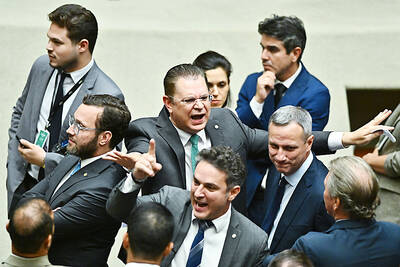For almost 500 years, the arch that connects the largest Gothic cathedral in the world with its Renaissance sacristy has offered visitors a sumptuous, if little glimpsed — and even less studied — vision of religious bounty.
The 68 beautifully carved plates of food that adorn the archway in Seville’s cathedral offer rather more than bread and wine.
There are pigs’ trotters and wild strawberries, aubergines, clams and oysters. There are peaches, radishes, a skinned hare with a knife by its side, a squirrel served on a bed of hazelnuts and a plate of lemons across which a small snake slithers. There are also cakes and biscuits, and, more exotically, a dish of peppers newly imported from Mexico, which had fallen to Hernan Cortes and his men just over a decade before the carvers set to work.

Photo: EPA-EFE
The plates, which are all too often obscured when the huge wooden doors of the sacristy are open, are the subject of a new book by a Spanish art historian who has spent the past 11 years trying to unpick the secrets and meanings of the cathedral’s stone buffet.
“People don’t really see the carvings because of the doors and because they’re too busy looking at the sacristy dome, but the carvings have been there for 500 years and have never been properly studied,” Juan Clemente Rodriguez Estevez said. “They’ve gone unnoticed apart from being seen as a bit of a novelty.”
The arch, which was carved between 1533 and 1535, provides what Rodriguez calls a “snapshot of a seminal moment.”
Its still-life carvings are chapters in the social, religious, economic and cultural history of Seville and Spain as a whole, he said.
The Americas were a fresh and lucrative discovery, the end of the seven-century Reconquista, which culminated in the expulsion of the Jews, was a mere four decades distant, and the Reformation was sweeping Europe.
Contemporary theologians and mystics focused on the importance of the eucharist and sought to portray communion as “a great feast to which everyone was invited,” said Rodriguez, who teaches at the University of Seville.
His book, The Universal Banquet: Art and Food in Renaissance Seville, examines how food was used to strengthen Catholic identity, employed as an image of the abundant joys of the afterlife, and even deployed as a bridge between Europe and the Americas.
Pork, unsurprisingly, features three times among the 68 plates, but olive oil — a staple of Andalucia since Roman times — is curiously absent. Rodriguez’s theory is that it might have been left out on the orders of Baltasar del Rio, a bishop who was instrumental in the arch’s creation.
Despite making a name for himself in the church in both Rome and Seville, Del Rio was from a family of conversos — Jewish converts to Catholicism — and his father was judged by the Inquisition at the end of the 15th century.
Mindful of his roots, the bishop might have chosen to exclude oil because it was used by Jews, who like Muslims — but unlike Catholics — did not fry their food in pig fat.
“Being a converso, Del Rio would have had to be very careful about the foods that were represented in the arch. They all needed to be really Catholic, but there are some foods that have a Jewish influence, such as the aubergines,” Rodriguez said. “Aubergines came to Europe through Islam, and came to be prized by Muslims and Jews alike. I think the presence of aubergines shows how normalized they had become by then.”
The bread at the center of the arch could also be a reference to Del Rio’s decision to found a brotherhood to help feed Seville’s poor.
“There was a terrible famine in 1521 and he ordered cheap wheat to be bought so that the poor would be provided with bread when wheat prices rose. If you look at the middle of the arch, you can see the loaves of bread,” Rodriguez said.
The peppers, which he had taken for strawberries until one of the botanists he consulted set him straight, are the only crop from the Americas.
“There aren’t more foods from there because it was still early days,” he said. “At that time, corn was mainly used as animal feed and the potato hadn’t arrived in Spain because the conquest of Peru took place in the 1530s, so the ships from Peru were only beginning to arrive.”
The traffic was not all one way.
The Augustinian friars who followed the Dominicans and the Franciscans to the Americas built three churches in Mexico in the 1560s whose doorways were decorated with plates of food, Rodriguez said.
The aim was to celebrate the eucharist and to help explain the importance of communion to a conquered people who were not familiar with bread and wine.
Rodriguez is delighted with the fruit of his more than a decade’s research, and keen to stress that he owes a huge debt to the botanists, zoologists and other experts he consulted on his physical and intellectual travels.
“I couldn’t have written the book if it wasn’t for the decades of work by researchers who have helped us understand food in a cultural context,” he said. “All I would have seen was a load of plates. When I started looking at the arch, I saw a window on to the 16th century, but I wasn’t quite sure what was on the other side.”

PARLIAMENT CHAOS: Police forcibly removed Brazilian Deputy Glauber Braga after he called the legislation part of a ‘coup offensive’ and occupied the speaker’s chair Brazil’s lower house of Congress early yesterday approved a bill that could slash former Brazilian president Jair Bolsonaro’s prison sentence for plotting a coup, after efforts by a lawmaker to disrupt the proceedings sparked chaos in parliament. Bolsonaro has been serving a 27-year term since last month after his conviction for a scheme to stop Brazilian President Luiz Inacio Lula da Silva from taking office after the 2022 election. Lawmakers had been discussing a bill that would significantly reduce sentences for several crimes, including attempting a coup d’etat — opening up the prospect that Bolsonaro, 70, could have his sentence cut to

China yesterday held a low-key memorial ceremony for the 1937 Nanjing Massacre, with Chinese President Xi Jinping (習近平) not attending, despite a diplomatic crisis between Beijing and Tokyo over Taiwan. Beijing has raged at Tokyo since Japanese Prime Minister Sanae Takaichi last month said that a hypothetical Chinese attack on Taiwan could trigger a military response from Japan. China and Japan have long sparred over their painful history. China consistently reminds its people of the 1937 Nanjing Massacre, in which it says Japanese troops killed 300,000 people in what was then its capital. A post-World War II Allied tribunal put the death toll

A passerby could hear the cacophony from miles away in the Argentine capital, the unmistakable sound of 2,397 dogs barking — and breaking the unofficial world record for the largest-ever gathering of golden retrievers. Excitement pulsed through Bosques de Palermo, a sprawling park in Buenos Aires, as golden retriever-owners from all over Argentina transformed the park’s grassy expanse into a sea of bright yellow fur. Dog owners of all ages, their clothes covered in dog hair and stained with slobber, plopped down on picnic blankets with their beloved goldens to take in the surreal sight of so many other, exceptionally similar-looking ones.

‘UNWAVERING ALLIANCE’: The US Department of State said that China’s actions during military drills with Russia were not conducive to regional peace and stability The US on Tuesday criticized China over alleged radar deployments against Japanese military aircraft during a training exercise last week, while Tokyo and Seoul yesterday scrambled jets after Chinese and Russian military aircraft conducted joint patrols near the two countries. The incidents came after Japanese Prime Minister Sanae Takaichi triggered a dispute with Beijing last month with her remarks on how Tokyo might react to a hypothetical Chinese attack on Taiwan. “China’s actions are not conducive to regional peace and stability,” a US Department of State spokesperson said late on Tuesday, referring to the radar incident. “The US-Japan alliance is stronger and more